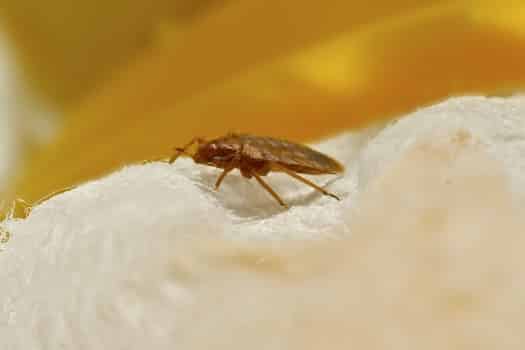When you think of bed bugs, you probably imagine a creature that spends all its life living inside a mattress. And while this is typically true, bed bugs are adaptable. They can live in many areas of the home, and get inside the smallest cracks that you’d never believe them to fit into.
Bed bugs can climb up almost any material to reach their food source (the host). They can scale walls, curtains, wooden furniture, and bed frames. The only surfaces that bed bugs can’t climb are extremely smooth glass, metal, and plastic.
We’ll look into which surfaces bed bugs can and can’t traverse. We’ll take a peek into their physiology that allows them to navigate their environment, and how to get bed bugs to come out of their hiding spots.
Do Bed Bugs Crawl on Walls and Ceilings?
According to their name, most bed bugs tend to establish themselves in beds. However, the bed itself is not the only place that bed bugs can be found. They can establish themselves anywhere which is close enough to your bed for them to reach you when they’re hungry.
Not only does this include carpets and furniture, but also walls and ceilings. Yes, bed bugs can scale walls and even crawl across ceilings to find a hiding spot (or food).
So how do they do it? If you look at your wall, you may notice that it’s not perfectly smooth. Paintwork and wallpaper both contain minuscule bumps and notches.
Bed bugs have claws at the ends of their legs, which they use to grasp these notches to avoid falling off. As they are so lightweight, their legs don’t have any trouble supporting them as they climb.
Some bed bugs use the wall as a place to live when they aren’t feeding. In particular, cracks and crevices (such as the gap between the wall and the baseboard) make excellent bed bug hiding spots.
When they get hungry, they crawl down the walls and make their way to your bed. If they aren’t looking for food, they may be searching for a mate, or somewhere to lay their eggs. Cracks and crevices in walls and headboards are a prime laying spot, as they’re out of the way.
Do Bed Bugs Crawl On Walls During the Day?
You might believe that bed bugs are strictly nocturnal predators. After all, they tend to bite people when they’re sleeping at night. They don’t tend to come out when it’s light, so would you ever find bed bugs on walls in the daytime?
Surprisingly, the idea that bed bugs are scared of the light is false. Bed bugs choose to come out at night more often than the daytime. This is because years of specialized evolution has taught them that it’s easier to feed in darkness.
During the night, there’s a lower chance they’ll be detected due to the cover of darkness. Not only that but at night, their hosts are more likely to be sleeping. It’s easier to feed when the host is still.
For this reason, it’s not particularly likely that you’ll see bed bugs crawling up your walls in the daytime. Generally speaking, the majority of bed bug activity will be during the night, and therefore go unnoticed by a home’s occupants.

That being said, this doesn’t mean you can leave your lights on at night and expect the bed bugs never to come out again. Light does not work as a bed bug deterrent for very long.
If a bed bug is hungry, they’ll come out in search of food even when it’s light. At most, you might deter them for a day or two until they can’t wait any longer.
Can Bed Bugs Climb Wood and Fabric?
So, walls are no match for bed bugs, whether they’re painted or papered. But what about fabric and wood?
Bed bugs can traverse fabric with ease. They spend almost their entire lives living in mattresses and bedding. To get to you, they have to maneuver through the fabric of your sheets. Not only can they move through fabric, but they’re incredibly good at it.
Their flat bodies mean that they can squeeze through the smallest gaps in between sheets and mattress covers. Their claws make it easy for them to hook onto cotton, polyester and other soft materials. This is actually how bed bugs make it into homes in the first place – they climb into luggage and clothes to hitch a ride.
But what about wood? Sadly, bed bugs won’t stop at fabric, either. Wood (especially varnished or lacquered wood) feels quite smooth, and you might wonder how they could scale it.
But you have to remember that you have very large fingers, compared to a bed bug’s tiny claws. What feels smooth to you is not smooth at all on a microscopic level.
As wood is a natural material, it’s full of tiny ridges and indentations that you can’t feel very easily. These are exactly what the bed bug uses to get a grip.
This means that bed bugs can climb wooden bed frames, dressers and other pieces of furniture with ease. It might take them a while to make it up, but they’re not doing anything else with their day.

Can Bed Bugs Climb Metal or Plastic?
Bed bugs find it extremely hard to navigate very smooth surfaces. Materials such as plastic, metal, and glass are often too slippery for bed bugs to climb up.
You can purchase (or make) bed bug interceptor traps, made out of plastic, to place under your bed legs. They consist of a small dish with a textured outer surface and a slippery inner one. Bed bugs can climb up into the trap, but can’t climb back out again, and can’t reach your bed leg. This means you can:
- Identify whether you have bed bugs
- Monitor them and figure out if bed bugs have returned if you’ve tried to get rid of them
- Stop bed bugs that aren’t already in your bed from reaching it.
According to the Journal of Economic Entomology, interceptor traps can eradicate low-level bed bug infestations if used abundantly. So they’re a great resource to have, and easy to make. However, it is important to bear in mind that not all metal, plastic and glass surfaces are alike.
Decorative glass and plastic objects are often “textured.” This gives the object a more interesting appearance, but it also creates a surface which bed bugs find it easier to climb. Likewise, if a surface is not completely vertical, bed bugs will find it easy to climb even if it is made of a smooth material.
For the best results, purchase purpose-made bed bug interceptor traps. These are specifically designed with ultra-high-gloss surfaces that bed bugs can’t traverse. If you make your own, you must ensure that whichever material you use is completely smooth.
Where Do Bed Bugs Hide?
Bed bugs are so named because beds are their natural habitat. As they don’t live on their hosts’ bodies, they have to choose a spot which is near enough that they can feed when necessary. Beds are the ideal place. They’re full of folds and creases in which to hide, and when you’re asleep, they’re near enough to grab a quick bite.
However, beds aren’t the only place where bed bugs hang out. As long as the area they’re in is close enough to get to you, they can live anywhere. As you know now, bed bugs can climb up and over almost any surface which is even lightly textured. Bed bugs can hide in:
- Bed frames and box springs
- Bedside cabinets, dressers, and wardrobes
- Lamps
- Electrical outlets
- Carpets and rugs
- Curtains and windowsills
- Electronics such as computer keyboards
- Cracks in walls, flooring, and baseboards
Bed bugs have been known to hang out on the ceiling and the top of curtain poles. So, if you have an infestation, don’t just check your bed. Search your entire bedroom, and leave no stone unturned.
How to Make Bed Bugs Come Out of Hiding
Bed bugs only drink blood, and they only have two interests: eating and mating. The only things that bed bugs respond to are:
- Carbon dioxide and other chemicals released by humans
- Warmth
- Pheromones released by other bed bugs
- The darkness, as this is a signal that any humans nearby may be sleeping
Carbon dioxide lure traps can entice bed bugs out, according to a study in Medical and Veterinary Entomology. However, these aren’t commercially available. A quick way to make your own is to add warm water, sugar, and yeast into a smooth plastic cup.
As the yeast consumes the sugar, it produces carbon dioxide. Attach a paper towel to the outside to give the bed bug something to climb up. When it falls inside the cup, it won’t be able to get out again.
If you don’t have yeast to hand, you’ll have to use yourself as a lure. Wait until nightfall. Get into bed and wait there for at least an hour, to give the bed bugs a chance to get to you.
Then, switch on the light. Chances are you’ll catch bed bugs on your bedding, or feeding on you. This will give you a chance to kill them using a contact killer such as tea tree oil or a pesticide.
Alternatively (and this may be your better option), follow them back to their hiding place to see where they go. Then, you’ll know where to start applying products such as diatomaceous earth.


My downstairs apartment dweller had bed bugs we found a box of bed bug killer in the laundry room after she was just in there. She hadn’t told anyone yet and I think she’s trying to handle it in her own. I live upstairs in the second floor (only two floors) abs across the hall from her side. Do you think the bugs will move into our apartment? We just literally gig finished with mold this is too much!